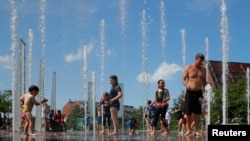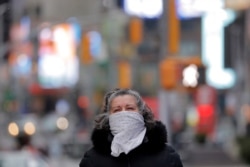Since the COVID-19 pandemic first erupted in China this winter, hopes have lingered that the outbreak would die down with the change of seasons.
"A lot of people think that goes away in April with the heat," U.S. President Donald Trump said at a meeting with governors in February.
April came and went and the pandemic rages on. But as Northern Hemisphere summer approaches, experts are starting to see a small impact from rising temperatures and humidity.
It won't stop the pandemic, they say. But it may help slow down the number of new infections. And the effects of weather may help to explain why parts of the tropics have not been hit quite as hard as temperate regions of the globe.
COVID season
COVID-19 is caused by a coronavirus, a large family of respiratory viruses including some that cause common colds. Since these illnesses wax and wane with the seasons, some research has suggested COVID-19 would, too. But others found lesser or no impacts from weather changes.
Cold and influenza viruses spread more easily in the winter in part because the air is drier. Warmer summertime air naturally holds more moisture. Virus particles don't travel as far in the humidity.
"Those little particles in the air get soggy and collapse to the floor," explained Penn State University biologist Katriona Shea at the Center for Infectious Disease Dynamics. "That's not a technical description."
Some scientists forecasting the spread of the disease are starting to incorporate temperature into their models.
"We see this correlation, roughly about a 2% reduction in transmission for every degree Celsius increase in temperature," said Director Christopher Murray at the University of Washington Institute for Health Metrics and Evaluation.
"It's not a huge effect," he added, but at hotter temperatures, it could make a difference.
The question is not settled, however.
"Are we sure about that? No," Murray cautioned. "Are there no people in the scientific community who believe that seasonality or temperature effects may be larger? Absolutely."
One of the latest studies to look at the effects of weather found a similar impact: about a 3% transmission change for each degree. Relative humidity and atmospheric pressure added to the effect.
"Weather alone cannot quench the epidemic in summer, even though it does help reduce the transmission rates to some extent," said study co-author Hazhir Rahmandad, an MIT associate professor of system dynamics.
Tropical depression
Using virus transmission and weather data from more than 3,700 locations around the globe, the authors estimated how much weather affects how the virus spreads in the world's most populous cities.
Heat and humidity "may partially explain the smaller sizes of outbreaks in southern Asia and Africa to date," the authors wrote.
While the weather may lower the risk of transmission by around 25% during the hottest months of the year in northerly Boston, Massachusetts, a tropical city such as Lagos, Nigeria, sees more than a 40% decline from the effects of heat and humidity.
The virus still spreads under those conditions, however, as demonstrated by Singapore, where cases recently spiked to 700 to 800 per day.
"We can see that this virus has spread all over the world, with many different temperatures," said Universidad Católica de Valencia bioengineering professor Angel Serrano Aroca. "I believe that there is an effect of weather conditions, but I think that this virus is so contagious that there are other factors that are much more important."
Population density, social-distancing measures and public health tools such as testing and contact tracing likely have more of an impact than weather, experts said.
For Murray and colleagues at the University of Washington, "mobility is the most important (factor) and then testing per capita," he said.
When his group more than doubled their estimated COVID-19 death toll in the United States, from 60,000 in mid-April to 135,000 last week, it was largely because states were loosening social distancing and individuals were moving around more even in supposedly locked-down areas.
Temperature is probably "important, yet minimal," he said.
Scientists still have a lot to learn about the virus, however.
"As some places warm up," Murray added, "we may get a stronger signal to understand better what the actual full temperature or seasonality effect will be."










